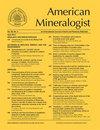9362R: Jianmuite, ZrTi4+Ti3+5Al3O16, a new mineral from the Allende meteorite and from chromitite near Kangjinla, Tibet, China
IF 2.7
3区 地球科学
Q2 GEOCHEMISTRY & GEOPHYSICS
引用次数: 0
Abstract
The new mineral jianmuite, ZrTi4+Ti3+5Al3O16 (IMA No. 2023-057) was found (1) as an inclusion in a corundum grain from the Cr-11 orebody near Kangjinla (29°11’N, 92°18’E), Tibet, China with wenjiite, Ti10(Si,P,☐)7, Al-rich spinel, osbornite, TiN, a Ca-amphibole particularly enriched in Ti, a Sr-rich dmisteinbergite, CaAl2Si2O8, and amorphous phases (probably residual melt) (holotype and first co-type) and (2) as several grains with corundum, mullite, Al6Si2O13, tistarite, Ti2O3, and kaitianite, Ti3+2Ti4+O5, in the matrix of the CV3 carbonaceous chondrite Allende (second co-type). Eight energy-dispersive spectroscopic analyses of the holotype normalized to 100% gave SiO2 1.83, ZrO2 23.17, Al2O3 18.41, Ti2O3 54.32, Sc2O3 1.25, MgO 1.03, Total 100.00 wt%. The empirical formula calculated on the basis of 10 cations and 16 oxygen atoms is VIIIZr VII(Ti3+3.034Ti4+0.602Zr0.364)Σ4.000VI(Ti3+1.845Al1.838Mg0.186Sc0.131)Σ4.000IV(Al0.780Si0.220)Σ1.000 O16. The simplified formula is Zr(Ti3+,Ti4+,Zr)4(Ti3+,Al)4(Al,Si)O16 and the ideal chemical formula is ZrTi4+Ti3+5Al3O16, which requires ZrO2 17.23 calculated wt%, TiO2 11.16 calculated wt%, Ti2O3 50.23 calculated wt% and Al2O3 21.38 calculated wt%, Total 100 wt.%. Six energy-dispersive spectroscopic analyses of the first co-type normalized to 100% gave SiO2 2.86, ZrO2 23.06, Al2O3 18.10, Ti2O3 53.78, Sc2O3 1.17, MgO 1.04, Total 100.00 wt%. Three-dimensional electron diffraction of the holotype determined jianmuite as I-centered tetragonal, space group: (I-4) (# 82), with a = 10.3675 (10) Å, b = 10.3675 (10) Å, c = 9.8125 (10) Å, V = 1054.70 (18) Å3 and Z = 4. Wavelength-dispersive spectroscopic electron probe microanalyses of Allende jianmuite (second co-type) gave for the two grains (5 analyses each) SiO2 2.32, 3.02, ZrO2 13.95, 10.79, Al2O3 26.82, 21.83, Ti2O3 44.68, 49.47, TiO2 12.62, 14.75, Sc2O3 0.12, 0.04, MgO 0.19, 0.80, FeO, 0.52, 0.55, CaO 0.17, 0.08, Total 101.40, 101.34 wt%.Weight% TiO2 and weight% Ti2O3 were calculated from formula units Ti+4 and Ti+3, which were determined assuming a stoichiometry of 10 cations and 16 oxygen atoms. Electron backscatter diffraction (EBSD) patterns on the Allende jianmuite (second co-type) can be indexed by the tetragonal I-4 structure obtained on the holotype, with a mean angular deviation of ~0.7°, thereby confirming identification of the Allende mineral as jianmuite. The structure of jianmuite consists of cations packed in distorted I-centered cubes. There are 8 independent cation sites, two inside distorted cubes with tetragonal ridged faces (CN = 8), two inside capped trigonal prisms (CN = 7), two inside distorted octahedra (CN = 6) and two inside tetrahedra (CN = 4). All coordination polyhedra are connected by edges, except for the tetrahedra, which are connected by vertexes with other polyhedra. Despite the similarity in composition with carmeltazite, ZrTi3+4Al2O11, the structures of the two minerals bear little resemblance to one another, most notably the number and type of cation-oxygen polyhedra. Instead, the jianmuite structure has several features in common with structures of pyrochlore-supergroup minerals, including similarity in unit cell parameters, cubic a ≈ 10 Å and tetragonal a ≈ c ≈ 10 Å in pyrochlore and jianmuite, respectively, and cation packing being cubic I-centred in both structures.9362R:来自阿连德陨石和中国西藏康金拉附近铬铁矿的新矿物建陨石,ZrTi4+Ti3+5Al3O16
在中国西藏康金拉(北纬 29°11,东经 92°18)附近的 Cr-11 矿体中,发现了新矿物尖晶石 ZrTi4+Ti3+5Al3O16(IMA No.2023-057)是在中国西藏康金拉(北纬 29°11',东经 92°18')附近 Cr-11 矿体的一个刚玉晶粒中发现的(1),该晶粒中含有温氏尖晶石、Ti10(Si,P,☐)7、富铝尖晶石、乌蛇纹石、TiN、一种钙闪石(尤其富含 Ti)、一种富 Sr 的闪长岩(dmisteinbergite)、CaAl2Si2O8 和无定形相(可能是残余熔体)(主型和第一共型);(2)在 CV3 碳质软玉阿连德(第二共型)的基质中,表现为几粒刚玉、莫来石、Al6Si2O13、榍石、Ti2O3 和开天石(Ti3+2Ti4+O5)。对主型进行的八次能量色散光谱分析归一化为 100%,得出 SiO2 1.83、ZrO2 23.17、Al2O3 18.41、Ti2O3 54.32、Sc2O3 1.25、MgO 1.03、总计 100.00 wt%。根据 10 个阳离子和 16 个氧原子计算得出的经验公式为 VIIIZr VII(Ti3+3.034Ti4+0.602Zr0.364)Σ4.000VI(Ti3+1.845Al1.838Mg0.186Sc0.131)Σ4.000IV(Al0.780Si0.220)Σ1.000 O16。简化式为 Zr(Ti3+,Ti4+,Zr)4(Ti3+,Al)4(Al,Si)O16,理想化学式为 ZrTi4+Ti3+5Al3O16,其中需要 ZrO2 17.23 计算重量百分比、TiO2 11.16 计算重量百分比、Ti2O3 50.23 计算重量百分比和 Al2O3 21.38 计算重量百分比,总计 100 重量百分比。对归一化为 100%的第一种共型进行六次能量色散光谱分析,结果为 SiO2 2.86、ZrO2 23.06、Al2O3 18.10、Ti2O3 53.78、Sc2O3 1.17、MgO 1.04,总计 100.00 wt%。通过对主型晶体的三维电子衍射,确定黝帘石为 I 心四方晶,空间群:(I-4) (# 82),a = 10.3675 (10) Å,b = 10.3675 (10) Å,c = 9.8125 (10) Å,V = 1054.70 (18) Å3 和 Z = 4。对阿连德绳纹石(第二共型)的波长色散光谱电子探针显微分析表明,两个晶粒(各分析 5 次)的 SiO2 2.32、3.02,ZrO2 13.95、10.79,Al2O3 26.82、21.83,Ti2O3 44.68、49.47,TiO2 12.62、14.75,Sc2O3 0.12, 0.04, MgO 0.19, 0.80, FeO, 0.52, 0.55, CaO 0.17, 0.08, Total 101.40, 101.34 wt%.Weight% TiO2 and weight% Ti2O3 were calculated from formula units Ti+4 and Ti+3, which were determined assuming a stoichiometry of 10 cations and 16 oxygen atoms.阿连德绳纹石(第二共型)上的电子反向散射衍射(EBSD)图样可通过在主型上获得的四方 I-4 结构进行索引,其平均角度偏差约为 0.7°,从而确认阿连德矿物为绳纹石。黝帘石的结构由排列在扭曲的 I 型中心立方体中的阳离子组成。共有 8 个独立的阳离子位点,其中两个位于具有四方脊面的扭曲立方体内部(CN = 8),两个位于带帽三棱柱内部(CN = 7),两个位于扭曲八面体内部(CN = 6),两个位于四面体内部(CN = 4)。除了四面体通过顶点与其他多面体连接外,所有配位多面体都通过边连接。尽管与菱锰矿(ZrTi3+4Al2O11)的成分相似,但这两种矿物的结构几乎没有相似之处,最明显的是阳氧多面体的数量和类型。相反,菱锰矿的结构与辉绿超群矿物的结构有几个共同点,包括单胞参数相似,辉绿岩和菱锰矿分别为立方 a ≈ 10 Å 和四方 a ≈ c ≈ 10 Å,阳离子堆积在这两种结构中都是立方 I 型中心。
本文章由计算机程序翻译,如有差异,请以英文原文为准。
求助全文
约1分钟内获得全文
求助全文
来源期刊

American Mineralogist
地学-地球化学与地球物理
CiteScore
5.20
自引率
9.70%
发文量
276
审稿时长
1 months
期刊介绍:
American Mineralogist: Journal of Earth and Planetary Materials (Am Min), is the flagship journal of the Mineralogical Society of America (MSA), continuously published since 1916. Am Min is home to some of the most important advances in the Earth Sciences. Our mission is a continuance of this heritage: to provide readers with reports on original scientific research, both fundamental and applied, with far reaching implications and far ranging appeal. Topics of interest cover all aspects of planetary evolution, and biological and atmospheric processes mediated by solid-state phenomena. These include, but are not limited to, mineralogy and crystallography, high- and low-temperature geochemistry, petrology, geofluids, bio-geochemistry, bio-mineralogy, synthetic materials of relevance to the Earth and planetary sciences, and breakthroughs in analytical methods of any of the aforementioned.
文献相关原料
| 公司名称 | 产品信息 | 采购帮参考价格 |
|---|
 求助内容:
求助内容: 应助结果提醒方式:
应助结果提醒方式:


